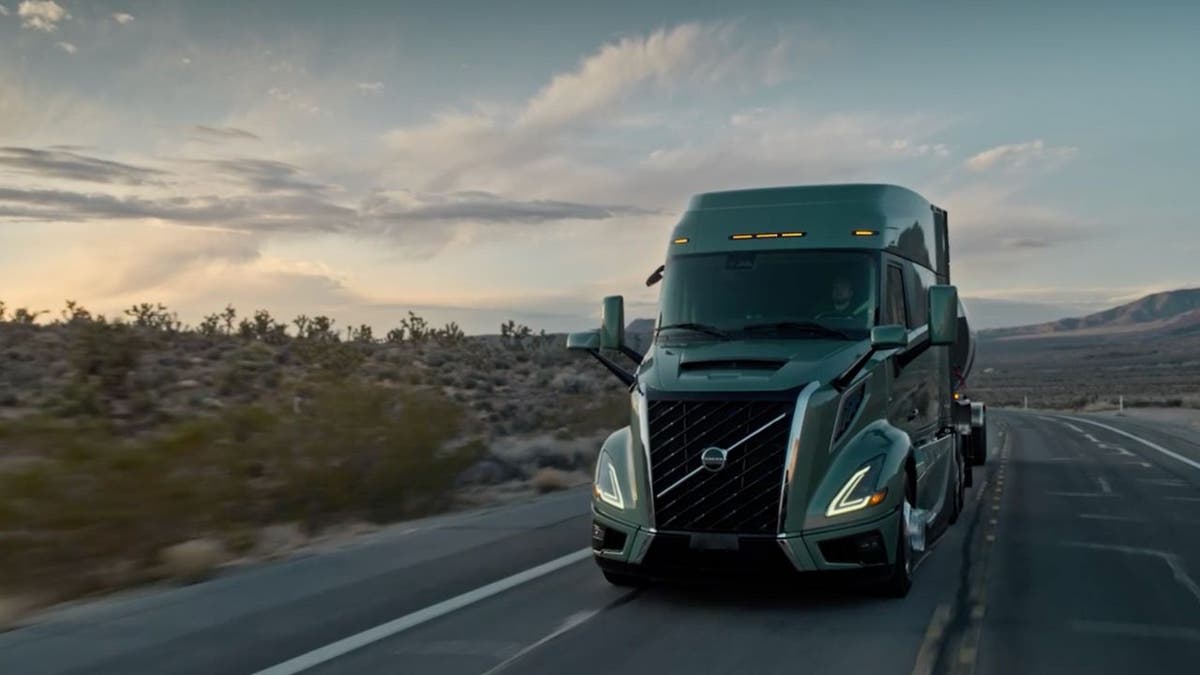Autonomous big rigs from Volvo and Aurora are coming to highways
Imagine cruising down the highway when suddenly a massive, self-driving 18-wheeler pulls up beside you. No human in the driver’s seat, just sensors and computers guiding this 40-ton behemoth down the road. A bit unsettling, right?
You’re not alone in feeling that way. Surveys show that 65% of people would feel unsafe sharing the road with an autonomous freight truck. And can you blame them? The idea of a vehicle that large operating without a human in control at high speeds is understandably concerning for most.
GET SECURITY ALERTS, EXPERT TIPS – SIGN UP FOR KURT’S NEWSLETTER – THE CYBERGUY REPORT HERE
Volvo VNL Autonomous truck (Volvo) (Kurt “CyberGuy” Knutsson)
Driverless 18-wheeler trucks hitting the road soon
But that’s exactly what could be headed to a highway near you as soon as this summer. Volvo and self-driving tech company Aurora have teamed up to create the Volvo VNL autonomous truck. This big rig is packed with Aurora’s autonomous driving smarts and redundant safety systems.
While it may seem jarring at first, their “self-driving truck” will actually have a human safety operator on board, at least initially. This person can take over if the autonomous systems encounter any issues. Volvo plans to start hauling freight loads with their autonomous trucks over the next few months as they prep for broader commercial operations. And Volvo has already kicked off manufacturing a launch fleet of autonomous trucks at their Virginia plant.

Volvo VNL Autonomous truck (Volvo) (Kurt “CyberGuy” Knutsson)
TESLA’S ELECTRIC SEMITRUCK TAKES ON A DIESEL BIG RIG
Safety is at the core of the Volvo VNL autonomous design
The Volvo VNL Autonomous truck has been designed with a strong emphasis on safety. According to Volvo Autonomous Solutions, the platform engineering approach incorporates high-assurance redundancy systems to mitigate potential emergency situations.
The truck has been built from the ground up, with redundant systems integrated for all safety-critical components like steering, braking, communication, computation, power management, energy storage and vehicle motion management. This intentional duplication of critical systems significantly enhances the autonomous truck’s safety and reliability.
The truck is also integrated with the Aurora Driver, a self-driving system that includes dual computers, self-driving software, in-house lidar that can detect objects more than 1,300 feet away, high-resolution cameras, and imaging radar.

Volvo VNL Autonomous truck (Volvo) (Kurt “CyberGuy” Knutsson)
HOW TO REMOVE YOUR PRIVATE DATA FROM THE INTERNET
Volvo and Aurora push toward commercialization
The reveal of the Volvo VNL Autonomous truck comes as both companies continue to push toward their stated goal of commercializing self-driving trucks by the end of 2024. Volvo initially plans to carry freight between Dallas and Houston using Class 8 trucks in autonomous mode with a safety driver behind the wheel.
Getting to commercialization is existential for Volvo and Aurora – two of the last autonomous trucking companies standing. Last year, Waymo Via put the brakes on its self-driving trucking program, and TuSimple recently left the U.S. market in favor of expanding in Asia. Aurora has not been immune to the high capital costs of developing and then launching commercial autonomous trucks either. In January, the company laid off 3% of its workforce to trim costs in advance of its commercial launch.
Consolidation in the AV industry has meant Aurora has fewer rivals. Einride, Torc, and Kodiak Robotics, which revealed its own purpose-built self-driving big rig, are among the few that remain.

Volvo VNL Autonomous truck (Volvo) (Kurt “CyberGuy” Knutsson)
Aurora’s commercialization strategy
The Volvo partnership, which the companies first inked in March 2021, is one part of Aurora’s commercialization strategy. Aurora has launched pilot programs with logistics companies FedEx, Ryder, Schneider and Uber Freight.
In January, Aurora and automotive supplier Continental closed the first phase of a more than $300 million project to mass-produce autonomous vehicle hardware for commercial self-driving trucks. The two companies finalized the design and system architecture for an AV hardware kit and the blueprint for a secondary computer that can take over operations if a failure occurs. The Continental hardware kit won’t be in Aurora trucks until 2027, but the Volvo VNL will still be packed with safety features, the company says.

Volvo VNL Autonomous truck (Volvo) (Kurt “CyberGuy” Knutsson)
Public acceptance is key
So, whether you’re ready or not, self-driving semitrucks look poised to hit America’s highways sooner than you think. The real questions are: Will the public’s safety concerns be alleviated? Will autonomous big rigs really make our roads safer and more efficient, as proponents claim? Overcoming consumer skepticism about sharing roads with robotic, driverless trucks is likely to be a major hurdle. Building public trust in the technology’s safety and reliability will be crucial for wider acceptance and adoption.
SUBSCRIBE TO KURT’S YOUTUBE CHANNEL FOR QUICK VIDEO TIPS ON HOW TO WORK ALL OF YOUR TECH DEVICES
Kurt’s key takeaways
The unveiling of the Volvo VNL Autonomous truck marks a significant milestone in the path toward commercializing self-driving trucks. With its redundant safety systems and cutting-edge autonomous driving capabilities, this truck could pave the way for a future where autonomous hauling becomes a reality on highways across the United States – if it can overcome the public’s very real safety concerns first.
How would you feel about sharing the highway with fully autonomous 18-wheeler trucks that have no human driver behind the wheel? Let us know by writing us at Cyberguy.com/Contact.
For more of my tech tips and security alerts, subscribe to my free CyberGuy Report Newsletter by heading to Cyberguy.com/Newsletter.
Ask Kurt a question or let us know what stories you’d like us to cover.
Follow Kurt on his social channels:
Answers to the most asked CyberGuy questions:
Copyright 2024 CyberGuy.com. All rights reserved.
